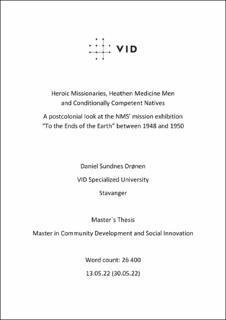| dc.contributor.author | Drønen, Daniel Sundnes | |
| dc.date.accessioned | 2022-09-09T08:23:35Z | |
| dc.date.available | 2022-09-09T08:23:35Z | |
| dc.date.issued | 2022-05 | |
| dc.identifier.uri | https://hdl.handle.net/11250/3016770 | |
| dc.description | Master in Community Development and Social Innovation, VID Specialized University, Stavanger, May 2022 | en_US |
| dc.description.abstract | Between 1948 and 1960, the travelling mission exhibition “To the Ends of the Earth” organized by the Norwegian Mission Society (NMS) travelled across Norway, informing Norwegians about the “mission fields” and the work that the mission organization did in them. Through a postcolonial archive study, the exhibition is revealed to have mainly been a tool to promote the significance of and the need for the missionaries. By presenting heathendom as the cause of the natives’ suffering, the NMS solidified their position as the only actor who could provide the help they needed. Beyond topics of religious nature, the exhibition is shown to have been quite ethnographic in its presentation of the mission fields. Through this, an ambivalent image of the native as both competent and infantile was presented, in which their competence was largely dependent upon their conversion to Christianity. Though the exhibition attempted to make the claim that the natives could become equal to the missionaries, a postcolonial reading of the material undermines this image. It also reveals that the exhibition’s presentation is unlikely to have been truthful, but rather an edited version of reality created to present the NMS favorably. | en_US |
| dc.description.abstract | Mellom 1948 og 1960 dro det Norske Misjonsselskaps (NMS) misjonsutstilling «Til Jordens Ender» gjennom Norge, og lærte nordmenn om «misjonsmarkene» og det arbeidet som misjonsorganisasjonen gjorde der. Gjennom en postkolonial arkivstudie viser misjonsutstillingen seg hovedsakelig å ha vært et verktøy for å fremme viktigheten av og behovet for misjonærer. Ved å framstille hedendom som årsaken til de innfødtes lidelser forsterket NMS sin posisjon som eneste aktør som kunne tilby hjelpen de innfødte trengte. Utover temaer av religiøs natur framsto utstillingen som å ha vært ganske etnografisk i sin presentasjon av misjonsmarkene. Gjennom dette ble et ambivalent bilde av de innfødte framstilt, hvor de var både kompetente og infantile, men hvor kompetentheten deres i stor grad var avhengig av deres konvertering til kristendom. Selv om utstillingen forsøker å påstå at de innfødte kan bli likeverdige med misjonærene, så blir dette inntrykket undergravet av en postkolonial lesning. Det avslører også at utstillingens framstilling mest sannsynlig ikke er sannferdig, men en redigert versjon av virkeligheten lagd for å framstille NMS positivt. | en_US |
| dc.language.iso | eng | en_US |
| dc.rights | Attribution-NonCommercial-NoDerivatives 4.0 Internasjonal | * |
| dc.rights.uri | http://creativecommons.org/licenses/by-nc-nd/4.0/deed.no | * |
| dc.subject | mission history | en_US |
| dc.subject | Norwegian mission society - NMS | en_US |
| dc.subject | misjonshistorie | en_US |
| dc.subject | dissemination | en_US |
| dc.subject | formidling | en_US |
| dc.title | Heroic Missionaries, Heathen Medicine Men and Conditionally Competent Natives : A postcolonial look at the NMS’ mission exhibition “To the Ends of the Earth” between 1948 and 1950 | en_US |
| dc.type | Master thesis | en_US |
| dc.description.version | published version | en_US |
| dc.source.pagenumber | 94 | en_US |

